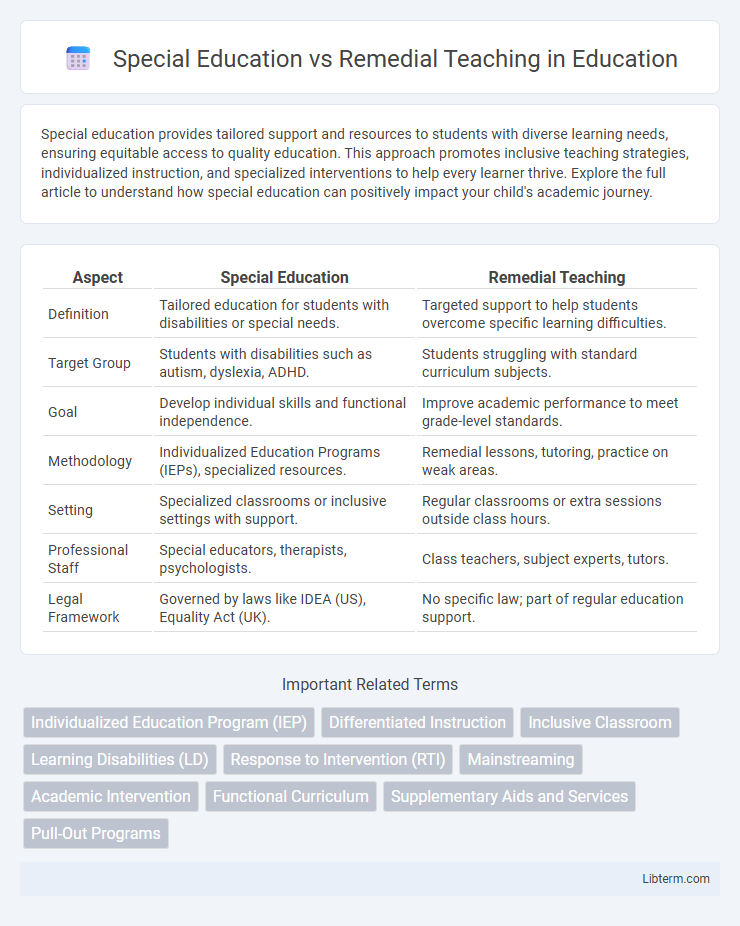Special education provides tailored support and resources to students with diverse learning needs, ensuring equitable access to quality education. This approach promotes inclusive teaching strategies, individualized instruction, and specialized interventions to help every learner thrive. Explore the full article to understand how special education can positively impact your child's academic journey.
Table of Comparison
| Aspect | Special Education | Remedial Teaching |
|---|---|---|
| Definition | Tailored education for students with disabilities or special needs. | Targeted support to help students overcome specific learning difficulties. |
| Target Group | Students with disabilities such as autism, dyslexia, ADHD. | Students struggling with standard curriculum subjects. |
| Goal | Develop individual skills and functional independence. | Improve academic performance to meet grade-level standards. |
| Methodology | Individualized Education Programs (IEPs), specialized resources. | Remedial lessons, tutoring, practice on weak areas. |
| Setting | Specialized classrooms or inclusive settings with support. | Regular classrooms or extra sessions outside class hours. |
| Professional Staff | Special educators, therapists, psychologists. | Class teachers, subject experts, tutors. |
| Legal Framework | Governed by laws like IDEA (US), Equality Act (UK). | No specific law; part of regular education support. |
Understanding Special Education: Definition and Purpose
Special education is a tailored instructional approach designed to meet the unique needs of students with disabilities, ensuring equitable access to learning opportunities. It encompasses specialized strategies, tools, and resources aimed at enhancing academic, social, and functional skills for learners with identified impairments. The primary purpose of special education is to provide individualized support that promotes independence and success within inclusive or specialized learning environments.
What is Remedial Teaching? Scope and Objectives
Remedial teaching targets students experiencing difficulties in specific subjects or skills, aiming to bridge learning gaps through tailored instruction and focused practice. The scope includes enhancing foundational skills in reading, writing, and mathematics, as well as addressing cognitive and developmental delays to align learners with the standard curriculum. Objectives emphasize improving academic performance, boosting confidence, and fostering independent learning to ensure students achieve grade-level competencies.
Key Differences between Special Education and Remedial Teaching
Special Education is a tailored instructional approach designed to meet the unique learning needs of students with disabilities, ensuring access to the general curriculum through individualized education plans (IEPs). Remedial Teaching targets students experiencing academic difficulties without diagnosed disabilities, aiming to bridge gaps in knowledge and skills through focused support in specific subjects. The primary difference lies in Special Education's legal mandate and specialized services for disabilities, whereas Remedial Teaching serves to enhance academic performance in typical learners requiring extra help.
Types of Students Served: Special Education vs Remedial Programs
Special education primarily serves students with identified disabilities such as autism, learning disabilities, and intellectual impairments, providing tailored instructional strategies to address individualized education plans (IEPs). Remedial teaching targets students experiencing general academic difficulties or skill deficits, particularly in areas like reading, writing, or math, aiming to bring them up to grade-level proficiency. Both programs focus on enhancing student learning but differ in the scope and nature of support based on specific educational needs.
Assessment and Identification Processes
Assessment in special education involves comprehensive evaluations using standardized tests, observational methods, and multidisciplinary team reviews to identify disabilities and tailor individualized education programs (IEPs). In remedial teaching, assessments primarily focus on diagnosing specific learning gaps through formative tests and progress monitoring to design targeted interventions. Identification in special education is legally mandated and requires eligibility determination under IDEA or similar laws, whereas remedial teaching identification is often more flexible, driven by classroom performance and teacher referrals.
Teaching Strategies in Special Education
Special education employs individualized teaching strategies tailored to diverse learning needs, utilizing techniques such as multisensory instruction, behavior modification, and assistive technology to support students with disabilities. These strategies emphasize personalized goal setting, differentiated instruction, and continuous progress monitoring to ensure effective learning outcomes. In contrast to remedial teaching, which focuses on addressing specific academic deficits, special education integrates social, emotional, and cognitive development through comprehensive, multidisciplinary approaches.
Remedial Teaching Methods and Approaches
Remedial teaching methods focus on tailored instructional strategies designed to address specific learning gaps and difficulties faced by students, employing techniques such as one-on-one tutoring, multisensory learning, and scaffolded instruction. These approaches emphasize diagnosis and continuous assessment to customize interventions that reinforce foundational skills in literacy, numeracy, and critical thinking. Effective remedial teaching integrates formative feedback and adaptive learning technologies to enhance student engagement and academic progress in mainstream or inclusive classrooms.
Roles of Teachers and Support Staff
Teachers in Special Education customize individualized instructional plans to meet diverse learning needs using adaptive strategies and assistive technologies, while support staff provide critical interventions such as speech therapy, occupational therapy, and behavioral support. In Remedial Teaching, educators focus on narrowing specific academic gaps by reinforcing core skills through targeted lessons and regular assessments, complemented by support staff who offer tutoring and remedial exercises to enhance student progress. Both roles emphasize collaboration to foster inclusive learning environments and optimize student achievement.
Legal Frameworks and Educational Policies
Special education operates under specific legal frameworks such as the Individuals with Disabilities Education Act (IDEA) in the United States, mandating individualized education plans (IEPs) and inclusive settings for students with disabilities. Remedial teaching, often guided by broader educational policies, targets students struggling with general academic skills without necessarily requiring legal mandates for special accommodations. Educational policies for special education emphasize rights and tailored services, whereas remedial teaching policies focus on curriculum support and skill enhancement within mainstream classrooms.
Choosing the Right Approach for Student Needs
Special education caters to students with identified disabilities requiring individualized instruction and support aligned with their unique cognitive and physical challenges. Remedial teaching targets learners struggling with specific academic skills, offering focused interventions to bridge gaps and enhance performance in standard curricula. Selecting the right approach depends on comprehensive assessment of the student's needs, ensuring tailored strategies that foster effective learning and development.
Special Education Infographic

 libterm.com
libterm.com